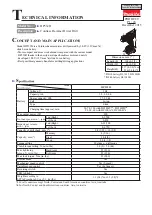
Cordless Tool
20
Battery Pack
2
Open the Box
Each cordless tool is shipped in a box with a battery pack and a charger. This chapter explains their operation and
how these components fit together.
2.1 Battery Pack
Before using the battery pack, read all instructions and cautionary markings on the charger, battery pack and the
QPM cordless tool.
The battery pack is not fully charged out of the box. Before using the battery pack and charger, read the safety
instructions in
“1.5 Safety” on page 5
and then follow charging procedures outlined in the charger
manual.
The battery pack should be recharged when it fails to produce sufficient power on jobs which were easily done
previously. DO NOT CONTINUE to use it under these conditions. Follow the charging procedure
“2.2.3 Charging
Procedure” on page 23
. You may also charge a partially used pack whenever you desire with no adverse
effect on the battery pack.
When ordering replacement battery packs, be sure to include the part number. Battery packs with model numbers
MCB204, DCB204 or DCB205 part # are compatible with charger MCB101.
2.1.1 Fuel Gauge
The battery packs include a fuel gauge which consists of three green LED lights that indicate the level of charge
remaining in the battery pack.
To actuate the fuel gauge, press and hold the fuel gauge button. A combination of the three green LED lights will
illuminate designating the level of charge left. When the level of charge in the battery pack is below the usable
limit, the fuel gauge will not illuminate and the battery pack will need to be recharged.
NOTE:
The fuel gauge is only an indication of the charge left on the battery pack. It does not indicate tool
functionality and is subject to variation based on product components, temperature and end-user application.
2.1.2 The RBRC™ Seal
The RBRC™ (Rechargeable Battery Recycling Corp oration) seal on the nickel cadmium, nickel metal hydride or
lithium ion batteries (or battery packs) indicate that the costs to recycle these batteries (or battery packs) at
the end of their useful life have already been paid by STANLEY. In some areas, it is illegal to place spent nickel
cadmium, nickel metal hydride or lithium ion batteries in the trash or municipal solid waste stream and the RBRC
program provides an environmentally conscious alternative.
RBRC™, in cooperation with STANLEY and other battery users, has established programs in the United States
and Canada to facilitate the collection of spent nickel cadmium, nickel metal hydride or lithium ion batteries.
Help protect our environment and conserve natural resources by returning the spent nickel cadmium, nickel metal
hydride or lithium ion batteries to an authorized STANLEY service center or to your local retailer for recycling. You
may also contact your local recycling center for information on where to drop off the spent battery pack.
RBRC™ is a registered trademark of the Rechargeable Battery Recycling Corporation.
2.1.3 Storage Recommendations
The best storage place is one that is cool and dry, away from direct sunlight and excess heat or cold.
!
Summary of Contents for QPM CORDLESS TOOL
Page 5: ...Instruction Manual V Table of Contents 5 9 Return Material Authorization RMA Procedures 49...
Page 6: ......
Page 23: ...Instruction Manual 17 Introduction...
Page 24: ......
Page 38: ......
Page 48: ......
Page 49: ...Cordless Tools 4 Preventive Maintenance Calibration Repairs Cleaning Disposal Maintenance...
Page 52: ......
















































